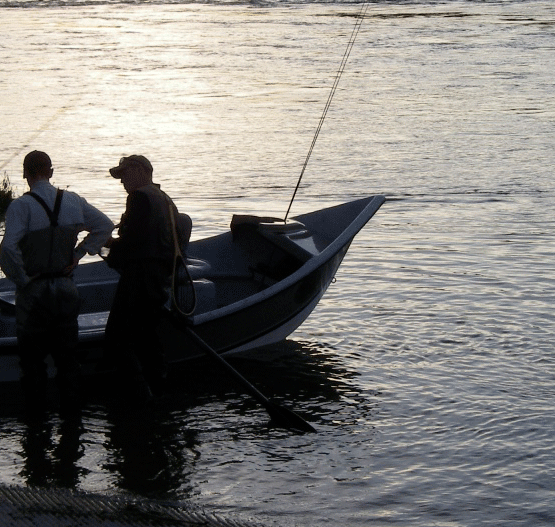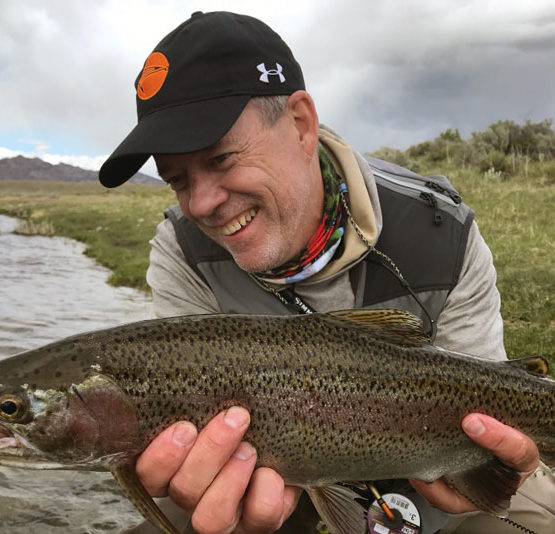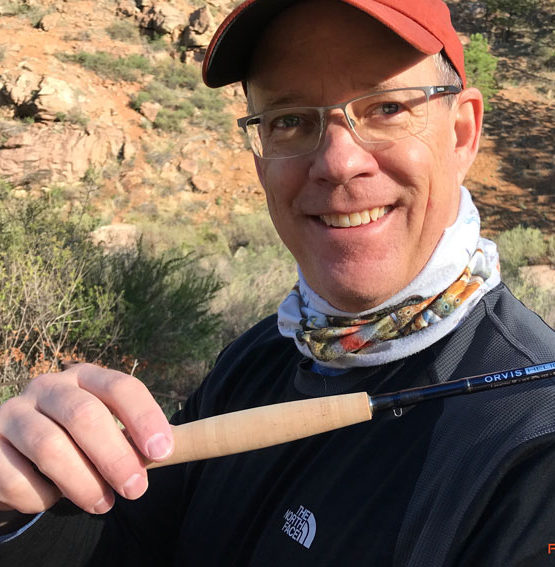Want to do more fly fishing without waders? In this post, I reveal 6 essential tips to help you get the most out of your next wet wading experience.
No doubt, waders have come a long way since their early all-rubber or all-neoprene days, but even though they’re made with lighter, more breathable materials, on a hot day, they can still make you feel like a steakhouse baked potato. On such occasions, the idea of fishing, Huck Finn style can be extremely appealing. So, if you’d like to ditch dry legs and do a bit of fly fishing without waders, here are 6 essential tips to make sure the experience doesn’t disappoint.
Disclaimer: This post may contain affiliate links, meaning we will receive a small commission (at no cost to you) if you click through and make a purchase.1. Wear Fishing Boots And Wading Socks
If most of your fly fishing is done along sandy beaches in Belize, let me first say, good for you and, secondly, you can probably ignore this tip. If you’re looking to do some wet wading on a rock-bottomed river or mountain lake, however, you should put aside the romantic notion of sandaled or barefoot wading in favor of ankle-supporting fishing boots with good treads, along with a made-for-the-job set of wading socks.
I realize such advice feels a lot like when your mother made you wear a jacket over your Halloween costume, but nothing ruins a warm summer fly fishing day like a broken ankle. Okay, fair enough, a snapped appendage may be a bit dire, but wading a slippery, rocky, current-swirly river in a pair of flip-flops is, at least, a contused ankle or crunched toe waiting to happen. Ain’t nobody got time for that!
An alternative would be to invest in a pair of wet wading shoes. They’re easy to find, generally not too expensive and serve the purpose of (sort of) protecting your feet. That’s just fine and dandy if you’re not crawling over slick boulders, dead logs and uneven terrain, but wading shoes, though light and cool-looking — in a hippy, earthy sort of way — lack ankle support. Vented as they are, they’re also no match for the sandbox full of annoying pebbles that will hold an immediate convention between the souls of the shoes and your tender little footsies.
Instead, just toss on a pair of wading socks (we like Simms Guide Wet Wading Socks and Orvis’ Neoprene Wet Wading Guard Socks), lace up your regular fishing boots and you’ll be good to go for a lovely day of wet wading with a dramatically reduced chance of day-wrecking injury or irritation. Besides, if you choose boots over sandals, your hike to and from the water will be a lot more pleasant and safe. Win, win!
2. Wear Quick-Drying Clothing
A lot of wet wading is done when the weather is hot and the flows are low, so being in over your knees is somewhat rare. That said, when was the last time we hopelessly hopeful anglers bypassed a sexy looking run just because it was on the wrong side of a deep wade? Thus, when wet wading, you will undoubtedly wind up with a pair of drenched shorts and, at the very least, a damp shirt.
Assuming you possess half an outdoor adventurer’s brain, you probably know that cold, wet clothing against human skin is a recipe for unexpected tragedy. Today’s awesome, quick-drying fabrics are one hedge against such a possibility. So, if you’re going in for some wet wading, abandon the cotton tees and shorts, and invest in some quick-drying clothes.
And, in case of sudden changes in the weather — which you should absolutely count on regardless of what your iPhone says — be sure to have quick access to warm, dry clothing or, better yet, a vehicle with a good heater. In other words, don’t get caught with your pants wet. More on this later.
P.S. Wet shorts are no place for your wallet. Yes, I’ve made that mistake.
3. Step Carefully
When we were kids growing up in the Colorado mountains, we used to have snowball fights in the winter and pinecone fights in the summer. As we got older, the snowballs became ice balls and we graduated from pinecones to dirt clods. As young teens, our puny brains shriveled to the size of Raisinettes as BB guns became the weapon of choice. And though the phrase “don’t try this at home” comes to mind, on one or two boredom-induced, dead-of-winter occasions, the BB gun wars raged from behind couches and bean-bag chairs in our families’ basements. Stupid. After all, everyone knows, “You could put an eye out!”
Why do I digress? Well, when fly fishing without waders, being stupid is… well… just as stupid. Although I make no claim as to the protective attributes of waders, I can say with a fair amount of confidence that they do protect you from some dangers wet wading simply can’t. So, when wet wading, be sure to step carefully, both in and out of the water.
Though you are unlikely to put an eye out, your exposed skin puts you at much greater risk of abrasions, encounters with various poisonous and/or thorny flora, picking up ticks and subjecting yourself to other nasty bug, spider and snake bites.
Anecdotally, I’ve been stung by a jellyfish and several bees. I’ve also received bites from spiders and a host of other creepy crawlies. Thankfully, though I’ve seen and disturbed several rattlesnakes in my time, I’ve never been bitten by one. I hear it can really ruin your day. The moral of the story? Don’t be stupid or even momentarily distracted.
Watch your step.
4. Protect Exposed Skin
Speaking of biting things, the romance of wet wading quickly sours when you become the blue plate special for mosquitos, noseeums, deer flies and horseflies. It’s also rather uncanny how the word of juicy human skin can spread so widely and quickly among mostly brainless beings without cell phones. In other words, where there’s one mosquito, umpteen billion of its closest friends are soon to follow.
Add a full day of water-reflected sun concentrated on wet skin, and parts of you could wind up looking like a warty red apple, to say nothing of the excruciating itch. Been there. Hated it. Never going back.
When wet wading, use both strong, waterproof sunscreen and bug repellent. Start with the sunscreen and follow with the repellent. And if you’re on the water a long time, reapply a few times throughout the day. I mean, at the end of the day, doesn’t the world have enough bad apples?
5. Get Out Of The Water
As refreshing as natural water can feel on our feet, ankles and knees, it won’t be long before a frigid, rushing flow turns your legs into a pair of pruny cherry popsicles.
Fly fishing has a strange tendency to make us practitioners ignore common bodily functions, urges and problems. The consuming pursuit of the catch seems to suppress all vital biological signals such as hunger, thirst and the urge to pee. It can also cause you to ignore the fact that your toes are one degree short of an Everest-style frostbite.
When wet wading, it’s a good idea to get out of the water regularly. Let your clothes dry while your legs and feet warm. I’m sure Bear Grylls would approve of such a strategy.
6. Don’t Challenge Nature — You’ll Lose
Since we’re channeling Bear Grylls, let’s all genuflect to his reverence for the killing power of nature, and vow to never challenge bad weather, especially when fly fishing without waders.
Eons ago, I took an elective class in high school called “Environmental Living”. They should have called it, “How Nature Will 100%, For Sure Kill You” because, for the entire semester, I can’t remember one lesson that ended in anything but a horrifying environmental death scenario.
Not a day went by without our teacher telling us a story of how someone did something stupid (or didn’t do something smart) that resulted in hypothermia, frostbite or death. In his words, the unprepared party inevitably, “Became a statistic”. For a time during that class, I can remember being afraid to step foot outside, even if it was just to go to the mailbox! I got over it, but it left an indelible scar.
All joking aside, hundreds of people die of exposure every year. They venture out for a short hike, a mild river float, a one-night campout or take a day to wet wade and fly fish a well-known river… and nature turns on them. Unprepared, they suddenly find themselves in a dire situation because a fierce storm rolled in out of nowhere.
By the way, when lightning is in the air, standing in water waving a long rod is a bad move. Need a reminder? Here’s one.
Related Posts:
- What To Wear Under Waders In Summer
- What Is A Nymph Rig? And How To Set One Up
- What Are Forceps Used For In Fly Fishing?
- 7 Best Strike Indicators For Fly Fishing
- What Is The Best All-Around Fly Rod Weight?
Final Thoughts
Fly fishing without waders can be an incredibly fun, relaxing and soul-refreshing experience. Respect nature and come over-prepared. Better to have and not need than to need and not have. Don’t let the excitement of an unencumbered fly fishing day keep you from making smart decisions. In the words of Forrest Gump, “Stupid is as stupid does.”
If you enjoyed the post you just read — and, honestly, how could you not have? — we encourage you to hang around, read some others, get to know us and then, if the mood strikes you, sign up to receive Fly Fishing Fix in your inbox. Let’s wade through the wonderful world of fly fishing together!
Tight Lines!











Matt – I could read you all day. You should write a book. Thanks for the Information.